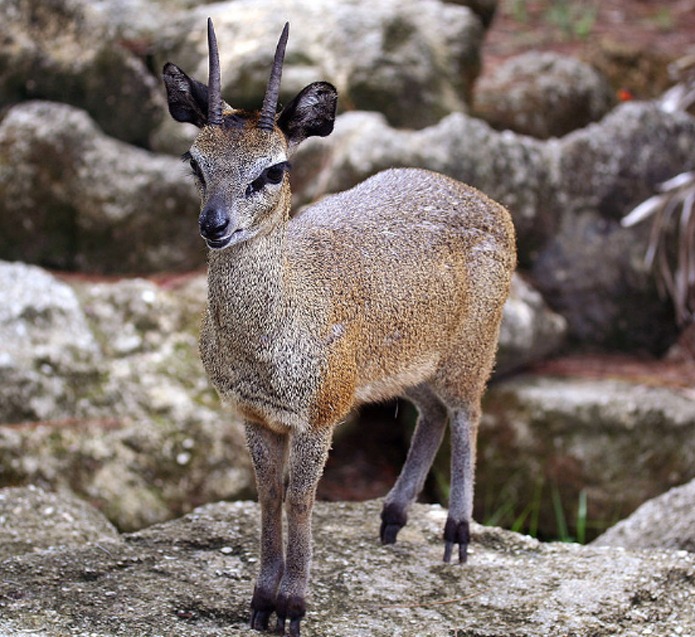The Klipspringer, also known as Oreotragus oreotragus, is a small antelope endemic to eastern and southern Africa. It is the only member of its genus. Its name is the Afrikaans term for “rock jumper” and it alludes to the antelope’s ability in a rocky habitat where it can be sighted moving carefree, seemingly on tiptoe.
The Klipspringer was first defined in 1783 by German zoologist Eberhard August Wilhelm von Zimmermann. A 2012 phylogenetic study posited that the Klipspringer shares a close relation with Kirk’s dik-dik and the Suni and said that the Klipspringer evolved nearly 14 million years ago. 11 subspecies have been recognized, although zoologists Peter Grubb and Colin Groves treat some of them as independent species in a 2011 publication:
- o. aceratos
- o. aureus
- o. centralis
- o. oreotragus
- o. porteousi
- o. saltatrixiodes
- o. schillingsi
- o. somalicus
- o. stevensoni
- o. transvaalensis
- o. tyleri
Since their population occurs in an extensive range and is on a stable rise, the International Union for the Conservation of Nature and Natural Resources (IUCN) Red List classified the antelope species as Least Concern. However, Klipspringers are still being hunted for their leather, hair, and meat. But hunting is not considered a major threat to their survival, as their habitats are usually inaccessible and unfavorable for hunting.
The physical characteristics of a Klipspringer
The Klipspringer is a small antelope that weighs between 8 and 18 kilograms, with females weighing slightly more than males. Its total body length stands between 75 and 115 cm. Its height ranges from 43 to 51 cm.
An adult Klipspringer has a stocky built with a short body and neck, and large hind quarters, which allow it to jump effectively from rock to rock. It has large, rounded ears, and its tail is small and rudimentary. The structure of a Klipspringer’s hooves is extraordinary because the last joints of the digits are rotated to walk on the tips of their hooves.
Like other antelopes, a Klipspringer has hollow and smoothed flat hairs that assist with the reflection of radiant heat, provide insulation from the thermal extremes, reduce moisture loss, and defend its body from injuries. The hairs are sparse at the base, and it darkens to a yellow-brown in the area near the tips. The hair coat color has shades of yellow, grey, brown, and read. One of its most notable features is its big, black pre-orbital gland.
Male Klipspringers are referred to as rams, while the females are referred to as ewes. Only rams possess short horns that are ringed at the base.
The distribution and habitat of Klipspringers
Klipspringers occur in large numbers across eastern and southern Africa, particularly in northeastern Sudan, Eritrea, Ethiopia, northern Somalia, east South Africa, coastal Angola, and coastal Namibia. Small populations can be found in the Central African Republic, southeastern Democratic Republic of Congo, Jos Plateau, and in Gashaka Gumti National Park in Namibia. Klipspringers are extinct in Burundi.
They are restricted to rocky habitats such as rocky hills, koppies, outcrops, and gorges with rocky sides. Klipspringers reside in rocky mountains as high as 4000 meters tall. They will also travel up to 10 km along flat areas between isolated koppies.
The behavior of Klipspringers
These antelopes are active during day and night, peaking early in the morning and late in the afternoon. During the hottest hours of the day, they would take shade to avoid the scorching heat. Rams and ewes form strong bonds, and both sexes defend their permanent territories. When a Klipspringer attempts to invade another Klipsringer’s territory, the ram will chase the intruder out of his territory. If the intruder persists, the Klipspringer will resort to presenting dominance displays, defensive displays, with fighting as its last resort.
Klipspringers form monogamous pairs. There are not much data about their mating practices, but it has been observed that rams closely follow females while they occasionally lift their forelegs. Rams may also create low humming calls and arch its neck to display its dominance.
The diet of a Klipspringer
Klipspringers are mainly browsers, feeding on fruits, young plants, and flowers. They also feed on grasses, especially during the wet season. They depend on succulent plants and not on water sources to meet their water needs.
Sources:
https://animaldiversity.org/accounts/Oreotragus_oreotragus/
http://www.krugerpark.co.za/africa_klipspringer.html
https://en.wikipedia.org/wiki/Klipspringer#cite_note-East-21
WILDLIFE PARKS AND RESERVES WHERE THIS SPECIES IS FOUND:
BOTSWANA
Mashatu Game Reserve
NAMIBIA
Damaraland
Etosha National Park
Namib-Naukluft Park
